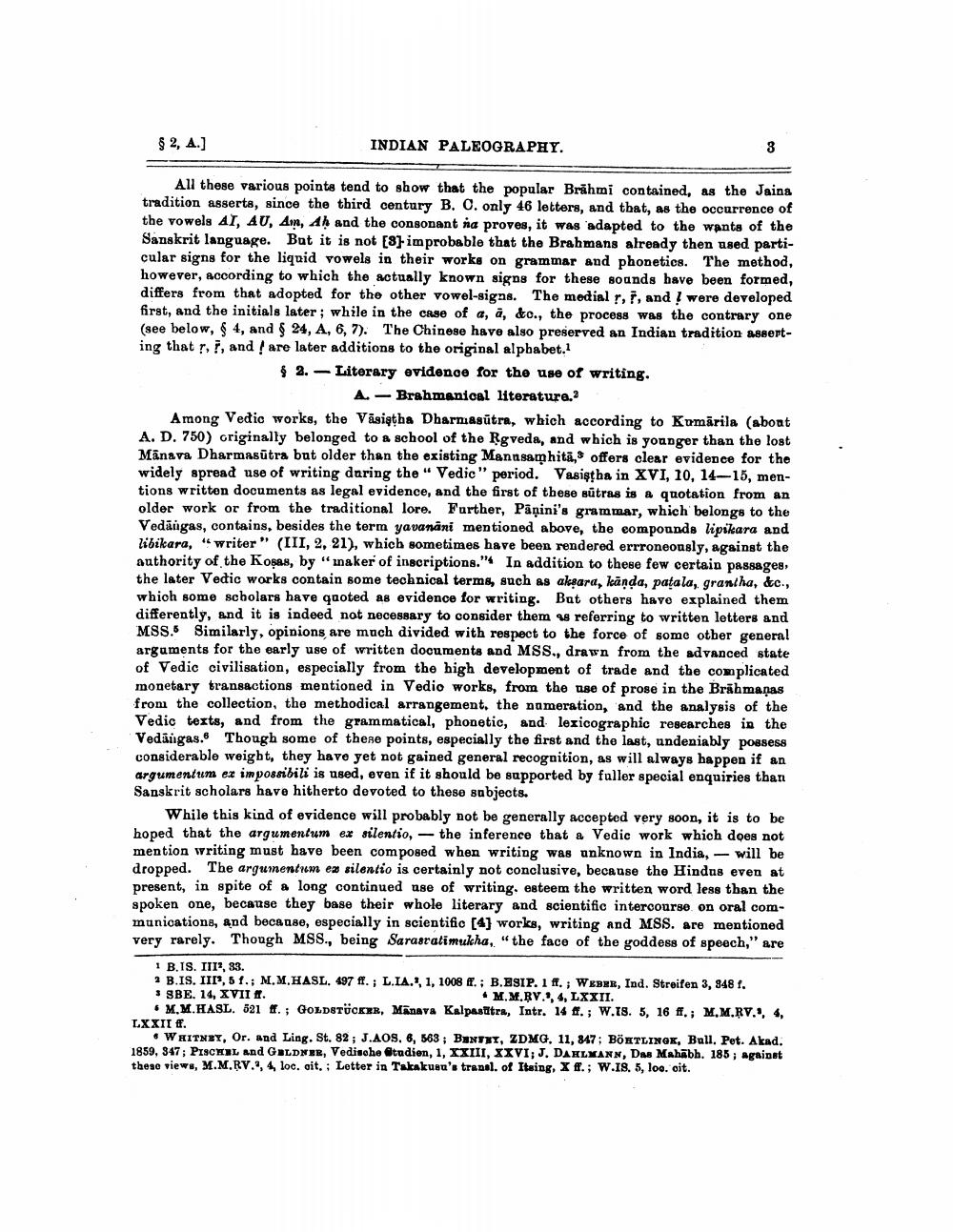________________
§ 2, A.]
INDIAN PALEOGRAPHY.
3
All these various points tend to show that the popular Brahmi contained, as the Jaina tradition asserts, since the third century B. C. only 46 letters, and that, as the occurrence of the vowels AI, AU, Am, Ah and the consonant na proves, it was adapted to the wants of the Sanskrit language. But it is not [8] improbable that the Brahmans already then used particular signs for the liquid vowels in their works on grammar and phonetics. The method, however, according to which the actually known signs for these sounds have been formed, differs from that adopted for the other vowel-signs. The medial r, F, and I were developed first, and the initials later; while in the case of a, a, &c., the process was the contrary one (see below, § 4, and § 24, A, 6, 7). The Chinese have also preserved an Indian tradition asserting that r, F, and are later additions to the original alphabet.1
2.
Literary evidence for the use of writing.
A.Brahmanical literature."
Among Vedic works, the Vasistha Dharmasutra, which according to Kumārila (about A. D. 750) originally belonged to a school of the Rgveda, and which is younger than the lost Manava Dharmasutra but older than the existing Manusamhita, offers clear evidence for the widely spread use of writing daring the " Vedic" period. Vasistha in XVI, 10, 14-15, mentions written documents as legal evidence, and the first of these sutras is a quotation from an older work or from the traditional lore. Further, Panini's grammar, which belongs to the Vedängas, contains, besides the term yavanani mentioned above, the compounds lipikara and libikara, "writer" (III, 2, 21), which sometimes have been rendered errroneously, against the authority of the Kosas, by "maker of inscriptions." In addition to these few certain passages, the later Vedic works contain some technical terms, such as aksara, kanda, patala, grantha, &c., which some scholars have quoted as evidence for writing. But others have explained them differently, and it is indeed not necessary to consider them as referring to written letters and MSS. Similarly, opinions are much divided with respect to the force of some other general arguments for the early use of written documents and MSS., drawn from the advanced state of Vedic civilisation, especially from the high development of trade and the complicated monetary transactions mentioned in Vedio works, from the use of prose in the Brāhmaṇas from the collection, the methodical arrangement, the numeration, and the analysis of the Vedic texts, and from the grammatical, phonetic, and lexicographic researches in the Vedängas. Though some of these points, especially the first and the last, undeniably possess considerable weight, they have yet not gained general recognition, as will always happen if an argumentum ex impossibili is used, even if it should be supported by fuller special enquiries than Sanskrit scholars have hitherto devoted to these subjects.
While this kind of evidence will probably not be generally accepted very soon, it is to be hoped that the argumentum ex silentio, the inference that a Vedic work which does not mention writing must have been composed when writing was unknown in India, will be dropped. The argumentum ex silentio is certainly not conclusive, because the Hindus even at present, in spite of a long continued use of writing. esteem the written word less than the spoken one, because they base their whole literary and scientific intercourse on oral communications, and because, especially in scientific [4] works, writing and MSS. are mentioned very rarely. Though MSS., being Sarasvatimukha, "the face of the goddess of speech," are
1 B.IS. III, 33.
2 B.IS. III, 5 f.; M.M.HASL. 497 ff.; L.LA.3, 1, 1008 ff.; B.ESIP. 1 ff.; WEBER, Ind. Streifen 3, 348 f. SBE. 14, XVII I. M.M.RV., 4, LXXII.
M.M.HASL. 521 ff.; GOLDSTÜCKER, Manava Kalpasitra, Intr. 14 ff.; W.18. 5, 16 ff.; M.M.RV.3, 4, LXXII #.
WHITNEY, Or. and Ling. St. 82; J.AOS. 6, 563; BENFET, ZDMG. 11, 847; BÖKTLINGK, Bull. Pet. Akad. 1859, 347; PISCHEL and GELDNER, Vedische Studien, 1, XXIII, XXVI; J. DAHLMANN, Das Mahabh. 185; against these views, M.M.RV., 4, loc. cit.; Letter in Takakusu's transl. of Itsing, X ff.; W.IS. 5, loc. cit.




